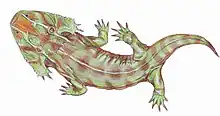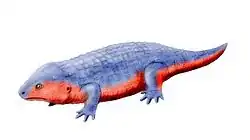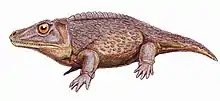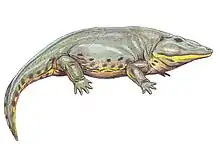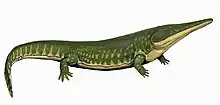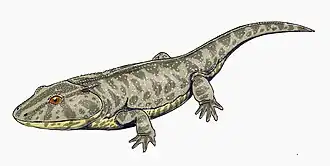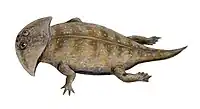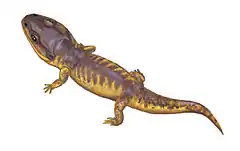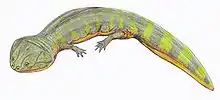Amphibamidae
The Amphibamidae are an ancient family of dissorophoid temnospondyls known from Late Carboniferous-Early Permian strata in the United States.[1]
| Amphibamidae Temporal range: Late Carboniferous–Early Permian, | |
|---|---|
 | |
| Amphibamus grandiceps | |
| Scientific classification | |
| Domain: | Eukaryota |
| Kingdom: | Animalia |
| Phylum: | Chordata |
| Class: | Amphibia |
| Order: | †Temnospondyli |
| Clade: | †Amphibamiformes |
| Family: | †Amphibamidae Moodie, 1909 |
| Subgroups | |
| Synonyms | |
| |
Classification
Amphibamidae has traditionally included small-bodied, terrestrial dissorophoids. The name is attributed to Moodie (1909),[2] but it was rarely used because it originally referred only to Amphibamus. Similar monogeneric families were also erected for other small, terrestrial dissorophoids (e.g., Doleserpetontidae), and most of the taxa now recognized as amphibamiforms were placed within the Dissorophidae.
Clack & Milner (1993) revived the Amphibamidae to include Amphibamus, Platyrhinops, Doleserpeton, and Tersomius[3]. Daly (1994) further expanded the composition of the Amphibamidae to include the newly described Eoscopus as well as the Early Triassic form Micropholis.[4] She suggested that the micromelerpetids were also amphibamids, which has not been validated by more recent workers. Subsequent phylogenetic work verified the monophyly of the Amphibamidae,[5] with recent analyses also recovering the branchiosaurids nested within the amphibamids.[6]
Schoch (2018) erected the new clade Amphibamiformes to include the traditional amphibamids and the nested branchiosaurids and subsequently restricted the Amphibamidae to two taxa: Doleserpeton annectens from the Dolese Brothers Limestone Quarry near Richards Spur, Oklahoma and Amphibamus grandiceps from Mazon Creek, Illinois. These taxa are united by several features, such as a medially expanded choana.
Phylogeny of amphibamiforms from Schoch (2018)
| Xerodromes |
| |||||||||||||||||||||||||||||||||||||||||||||||||||||||||||||||||||||||||||||||||||||||||||||||||||
Relationship to the Batrachia
The Amphibamidae have typically been recovered close to some or all of the lissamphibian crown. Until the description of Gerobatrachus, Doleserpeton was considered to be the closest extinct relative to the crown group.[7] Below is a modified cladogram from Anderson et al. (2008) showing Batrachia nested in the Amphibamidae, with Gerobatrachus as the sister taxon of Batrachia (anurans and caudates) and Doleserpeton and Amphibamus as successive outgroups:[7]
| Amphibamidae |
| ||||||||||||||||||||||||||||||||||||||||||||||||||||||||||||
There is continued debate over the origin of lissamphibians, including whether they are monophyletic or whether batrachians and caecilians are descended from different clades of tetrapods or temnospondyls.[8] If they are monophyletic, there is also a debate about which clade they are nested in, with some hypotheses suggesting a lepospondyl origin, in which case amphibamids would not be closely related to any extant amphibians.[9]
References
- Schoch, Rainer R. (2018). "The putative lissamphibian stem-group: phylogeny and evolution of the dissorophoid temnospondyls". Journal of Paleontology. 93 (1): 137–156. doi:10.1017/jpa.2018.67. ISSN 0022-3360.
- Moodie, Roy L. (1909). "A contribution to a monograph of the extinct Amphibia of North America. New forms from the Carboniferous". Journal of Geology. 17 (1): 38–82. Bibcode:1909JG.....17...38M. doi:10.1086/621585.
- Clack, Jennifer A.; Milner, Andrew R. (1993). "Platyrhinops from the Upper Carboniferous of Linton and Nyrany and the family Amphibamidae (Amphibia: Temnospondyli)". New Research on Permo-Carboniferous Faunas. 29: 185–191.
- Daly, Eleanor (1994). "The Amphibamidae (Amphibia: Temnospondyli), with a description of a new genus from the Upper Pennsylvanian of Kansas". The University of Kansas Miscellaneous Publications. 85: 1–59.
- Schoch, Rainer R.; Rubidge, Bruce S. (2005). "The amphibamid Micropholis from the Lystrosaurus Assemblage Zone of South Africa". Journal of Vertebrate Paleontology. 25 (3): 502–522. doi:10.1671/0272-4634(2005)025[0502:tamftl]2.0.co;2.
- Schoch, Rainer R.; Milner, Andrew R. (2008). "The intrarelationships and evolutionary history of the temnospondyl family branchiosauridae". Journal of Systematic Palaeontology. 6 (4): 409–431. doi:10.1017/s1477201908002460. ISSN 1477-2019. S2CID 86207414.
- Anderson, J.S.; Reisz, R.R.; Scott, D.; Fröbisch, N.B.; Sumida, S.S. (2008). "A stem batrachian from the Early Permian of Texas and the origin of frogs and salamanders" (PDF). Nature. 453 (7194): 515–518. Bibcode:2008Natur.453..515A. doi:10.1038/nature06865. PMID 18497824. S2CID 205212809. Archived from the original (PDF) on 2015-06-26. Retrieved 2015-06-25.
- Pardo, Jason D.; Small, Bryan J.; Huttenlocker, Adam K. (2017). "Stem caecilian from the Triassic of Colorado sheds light on the origins of Lissamphibia". Proceedings of the National Academy of Sciences. 114 (27): E5389–E5395. doi:10.1073/pnas.1706752114. ISSN 0027-8424. PMC 5502650. PMID 28630337.
- Marjanović, David; Laurin, Michel (2019). "Phylogeny of Paleozoic limbed vertebrates reassessed through revision and expansion of the largest published relevant data matrix". PeerJ. 6 (e5565): e5565. doi:10.7717/peerj.5565. PMID 30631641.


